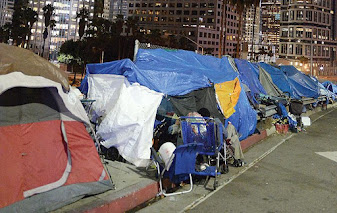The Homeless Crisis in Los Angeles
Dean Zamora
When you think of L.A. County you might think about Downtown LA fashion district, Little Tokyo, Staples Center, live music performances, Venice Beach, etc. Especially with the amount of tourism that L.A. County receives. However, a major thing that surrounds Los Angeles as well as all of California is the homeless population. While some cities may do a better job at hiding this fact it becomes very apparent how much of an issue this is when you travel to DTLA or Hollywood and witness the amount of people sleeping on the streets and all the tents that are propped up.
There are a lot of factors that can lead someone into being homeless aside from being financially instable. Factors such as:- being kicked out from home
- running away from home
- abuse
- recently released from jail
- mental health
- sexual identity
- etc...
In the article " 'I’m not homeless, I’m houseless': Identifying as Homeless and Associations with Service Utilization Among Los Angeles homeless young people. " by Hailey Winetrobe et al, they interviewed the homeless community around the L.A. County. From asking different members on what they believe their reason is for being homeless, they stated that they were
"being kicked/thrown out of their family/group/foster
home (42.1%), leaving their
family/group/foster home
on their own (33.1%), because of a conflict with
parents/guardians/caregivers (25.9%), and for independence (25.2%) and adventure
(25.0%)".
What is also astounding is how over last decade the homeless population has also increased substantially. "In the article Using Point-in-Time Homeless Counts to Monitor Mortality Trends Among People Experiencing Homelessness in Los Angeles County, California, 2015–2019", Will Nicholas et al look into how the homeless population has grown as well as their mortality rate here in Los Angeles. After calculating data from the Los Angeles MEC, they've come to the result that from the years 2015-2019 the homeless population "the PEH population increased by 50% from January 2015 to January 2020, from 44,359 to 66,436".
However, what was also shocking to see is how much the mortality rate of the homeless population has substantially increased as well. According to Nicholas et al, "From 2015 to 2019, deaths among PEH increased from 741 to 1267 and the crude mortality rate increased from 1624 to 2021"
This topic is important to me as its something I have witnessed a lot growing up here around Los Angeles. Whether that would be going to Downtown LA with my family to try out a restaurant or going around that area for a concert showing from my favorite groups, I would always see a lot tents on the side of the road or people sleeping on benches or the side walk. It always brought me some form of discomfort seeing this as there is still a lot that can be done to help provide assistance to this community, not only in providing them a place to call home but also help aid them in both their physical and mental health.
Nicholas, Greenwell, L., Henwood, B. F., & Simon, P. (2021). Using Point-in-Time Homeless Counts to
Monitor Mortality Trends Among People Experiencing Homelessness in Los Angeles County, California,
2015‒2019. American Journal of Public Health (1971), 111(12), 2212–2222.
https://doi.org/10.2105/AJPH.2021.306502
Winetrobe, Rhoades, H., Rice, E., Milburn, N., & Petering, R. (2017). “I’m not homeless, I’m houseless”:
identifying as homeless and associations with service utilization among Los Angeles homeless young
people. Journal of Social Distress and Homeless, 26(1), 16–24.
https://doi.org/10.1080/10530789.2017.1280204






No comments:
Post a Comment